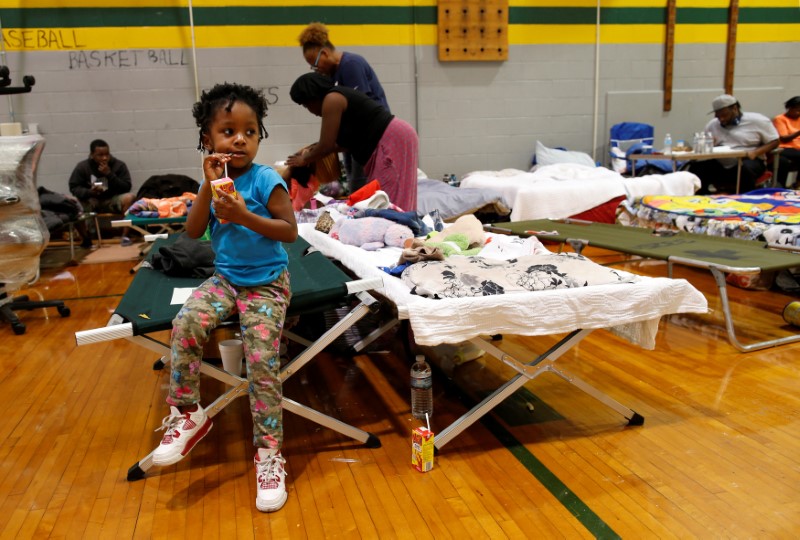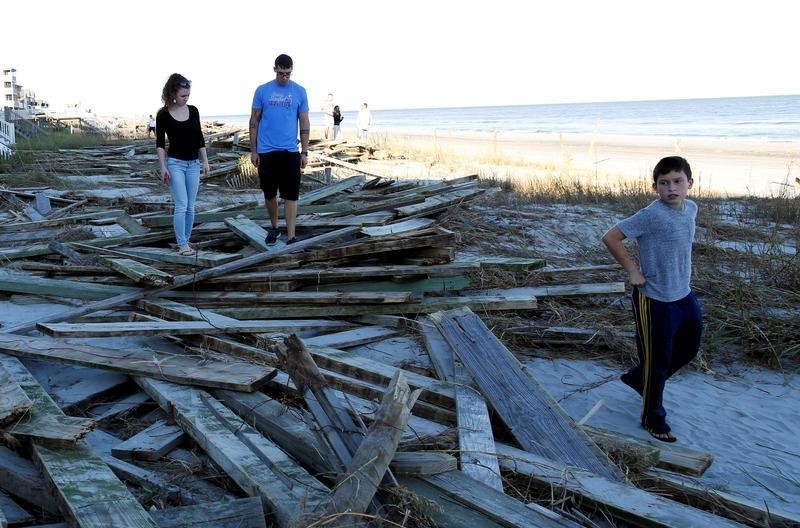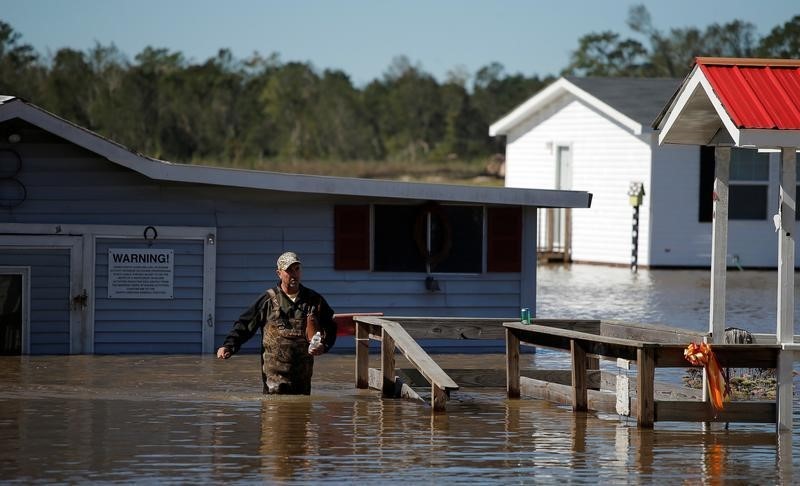
By Scott Malone and Harriet McLeod
JACKSONVILLE BEACH, Fla./CHARLESTON, S.C. (Reuters) – Hurricane Matthew made landfall on the U.S. coast in South Carolina on Saturday, packing a diminished yet still powerful punch after killing almost 900 people in Haiti and causing major flooding and widespread power outages in the U.S. Southeast.
The storm, which left flooding and wind damage in Florida, soaked coastal Georgia and South Carolina on Saturday but was packing a diminished punch. Wind speeds had dropped below 85 miles per hour (135 kph), making it a Category 1 hurricane, the weakest on the Saffir-Simpson scale of 1 to 5.
It made landfall near the town of McClellanville, north of Charleston, according to the National Hurricane Service, which warned a “serious inland flooding event” was unfolding.
At least four deaths in Florida were attributed to the storm, which knocked out power to least 1.5 million households and businesses in the southeastern United States.
In Florida, 775,000 were without power, according to state utilities, while in South Carolina 433,000 had no power, Governor Nikki Haley said. Georgia Power said at least 275,000 were without power in the state.
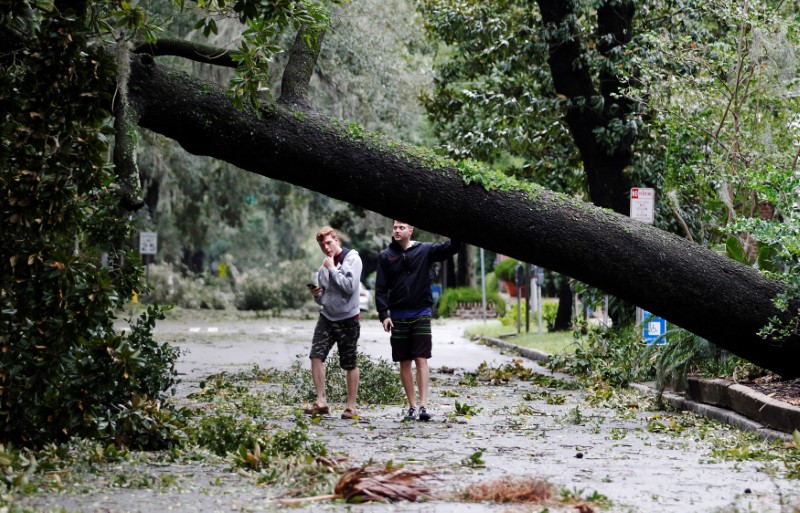
Josh Rhodes (L) and Tim Rossland look at a fallen tree in Telfair Square after Hurricane Matthew passed through in Savannah, Georgia October 8, 2016. REUTERS/Tami Chappell
Roads in Jackson Beach were littered with wood, including sections of a historic quarter-mile-long pier, and foot-deep (15 cm) water clogged intersections. Moderate damage could be seen on beachfront businesses, with fences and awnings torn down.
“We rode out the storm. It wasn’t this bad at our house, but here there’s a lot of damage,” said Zowi Cuartas, 18, as he watched people pick up shattered signs knocked down by the wind and waves near the beach. “We were prepared to lose our house.”
Governor Rick Scott of Florida said more than 6,000 people stayed in shelters on Friday night, but he appeared relieved at a news conference on Saturday the storm did not do more harm.
“We’re all blessed that Matthew stayed off our coast,” he said, though he also described extensive flooding, damaged roads, downed trees and homes without electricity. He predicted most people would have power back by Sunday evening. He did not comment on the reports of four deaths.
Streets in downtown Charleston were flooding up to the tops of tires on some cars and a few residents waded, some barefoot, near the city’s sea wall as high tide approached. At the High Battery at Charleston peninsula’s tip, waves were close to topping the sea wall with spray splashing onto East Bay Street.
“It blew like hell,” said resident and writer Roger Pinckney, 70.
Charleston officials said they were not aware of any deaths, injuries or significant structural damage. Winds and the threat of surges were expected to diminish through the day, National Weather Service forecaster James Carpenter said by telephone.
The toll in the United States was far less devastating than in Haiti, where at least 877 people were killed, a death toll that ticked up as information trickled in from remote areas, according to a Reuters tally of tolls from officials.
Matthew rampaged through Haiti’s western peninsula on Tuesday with 145 mph (233 kph) winds and torrential rain. Some 61,500 people were in shelters, officials said, after the storm hurled the sea into fragile coastal villages. The aid group Doctors Without Borders was flying people in by helicopter to deal with emerging cholera cases and warned there was a risk of a larger outbreak.
The Mesa Verde, a U.S. Navy amphibious transport dock ship, was en route to Haiti to support relief efforts. The ship has heavy-lift helicopters, bulldozers, fresh-water delivery vehicles and two surgical operating rooms. The U.S. government was also airlifting in blankets, hygiene kits, kitchen sets and plastic sheeting for emergency shelters, according to a statement by the United States Agency for International Development.
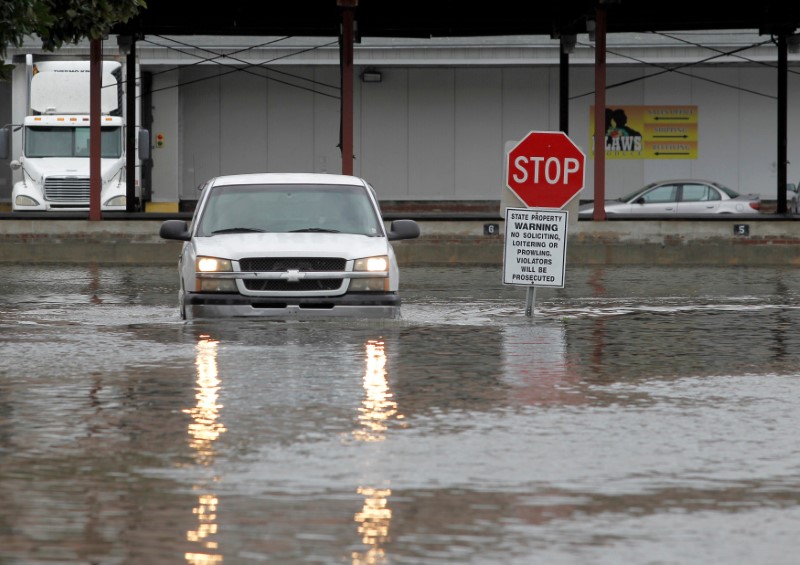
A truck passes through flooded water at a business after Hurricane Matthew passed through in Savannah, Georgia October 8, 2016. REUTERS/Tami Chappell
FLOODS PREDICTED
The NHC predicted the storm would possibly strike the U.S. coast on Saturday morning or afternoon.
“Regardless of whether or not the center makes landfall, hurricane-force winds in the northern eyewall will lash much of the coast of South Carolina,” an NHC advisory said.
Matthew sideswiped Florida’s coast with winds of up to 120 mph (195 kph) but did not make landfall.
Governors in several states held news conferences on Saturday morning, including Florida, North Carolina and South Carolina. North Carolina Governor Pat McCrory warned storm surges and high winds could cause serious problems and was “extremely concerned” that the hurricane downgrade would cause residents not to take warnings seriously.
Forecasters warned of flooding as 15 inches (40 cm) of rain were expected to fall in parts of the region along with massive storm surges and high tides.
Some 8 inches (20 cm) of rain had fallen in the Savannah, Georgia area where Matthew downed trees and caused flooding.
Though gradually weakening, Matthew – which triggered mass evacuations along the southeast U.S. coast – was forecast to remain a hurricane until it begins moving away on Sunday, the NHC said.
President Barack Obama and officials urged people to heed safety instructions.
Florida officials urged residents not to rush back to homes that still lacked power on streets clogged with debris.
“You are going to continue to see some flooding, damage and power outages,” Jacksonville Mayor Lenny Curry told reporters on Saturday, adding that the roads into the beach area would be reopened to residents around noon.
(Additional reporting by Brendan O’Brien in Milwaukee, Zachary Goelman in Orlando, Fla. and David Shepardson in Washington; Editing by James Dalgleish)


